(单词翻译:单击)
5.Beached Dolphins And Whales
5.搁浅的海豚和鲸鱼
In 2009, a group of false killer whales stranded themselves on a beach in South Africa. There were 55 individuals, and rescuers attempted to help them back into the water. But as soon as the rescuers had pushed the massive creatures back into the water, they forced their way up on shore again. The beaching started in the morning, and by the afternoon, it was decided that the most humane thing to do to the whales was to euthanize them.
2009年,一群拟虎鲸搁浅在南非的沙滩上。这群拟虎鲸总共有55头,施救人员正尝试着帮助它们重新返回大海。当救援人员刚把这群庞然大物推向水中的时候,它们却又奋力地游回了岸边。搁浅从早上就开始了,一直到下午前,救援人员才决定最佳的救援方案就是让它们安乐死。
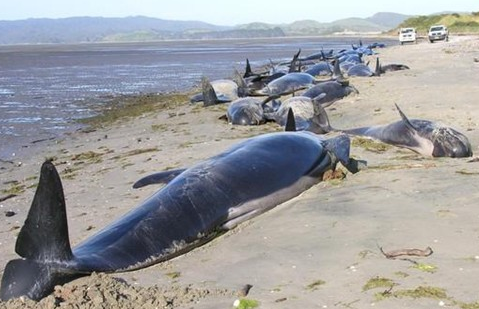
There are many stories about mass whale and dolphin beachings linked to military activity, sonar, underwater noise caused by shipping vessels, and even pollution. While that all might have something to do with it, the behavior dates back to well before the advent of any of these human innovations. There are records of mass beaching events in New England not long after the first European settlers arrived, and even Aristotle recorded instances of marine animals beaching themselves. It all seems to suggest that while it might be something that's aggravated by modern technologies like sonar, it might also be a natural behavior—and that makes no sense. It's possible that sick animals beach themselves to die, but that doesn't entirely explain why huge populations strand themselves all at once. The record for false killer whales, the species that was found fighting to stay on the beaches in South Africa, is 835 individual animals.
很多关于大量的鲸鱼和海豚搁浅事件都和军事活动,声纳,货船造成的水下噪音,甚至海洋污染有关。尽管这些都有可能导致搁浅的发生,但是早在人类的这些科学发明之前就已经出现了这样的搁浅状况。有记录显示,就在第一批欧洲定居者到来不久后,大规模的沙滩搁浅事件就发生了,甚至亚里士多德也记录到海洋生物的自我搁浅事件。所有这些似乎表明了现代科技比如像声纳,加重了这种状况的产生。但也表明了这些也有可能是动物本身的自然行为——但这种解释完全说不通。如果生病的动物们搁浅自己而死亡的说法行得通的话,那么为什么如此大规模的群体性搁浅事件就完全无法解释了。在这次南非沙滩上发现的拟虎鲸不愿重回海洋而是群体性搁浅至死的记录中,总共搁浅数量为835头。
4.Rhino-Riding Genets
4.骑在犀牛背上的麝猫
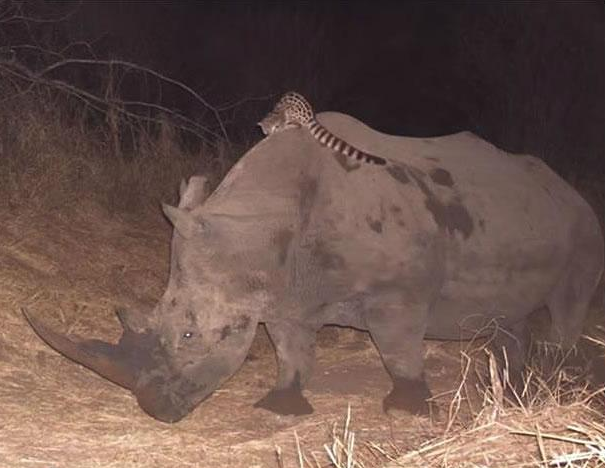
The genet is a small, cat-like animal native to north Africa. They're traditionally solitary animals, and although their territories can occasionally overlap, they spend most of their time alone. This isn't the case for one particular genet that's been spotted in South Africa's Hluhlwe-iMfolozi Park, not only making some unlikely friends, but going joyriding on his back every night.
麝猫是一种小型,外表像猫的北非本土动物。它们通常是独居的动物,尽管它们各自的领地会偶尔重合,它们多数时间里还是单独生活。但有一例除外,有人发现在南非的 Hluhlwe-iMfolozi公园里,麝猫们不但在和一些看起来不太可能的物种交朋友,还在每天晚上非常愉快地骑在它们的背上。
Cameras are set up throughout the park to monitor the population of black rhinos, but they caught something odd in the process. One of the local genets has apparently taken to riding around on the backs of the large herbivores that it shares its territory with, and no one knows why. The genet doesn't seem to prefer the company of any one rhino; it's been seen riding around on different rhinos and buffaloes alike, and it doesn't seem to be trying to get anywhere in particular, either. There are plenty of examples of birds landing on the big, hoofed animals, but there's usually an obvious purpose to it—the birds are getting a free meal while their mount is getting the gnats picked off. The genet doesn't seem to be doing it for any particular reason save perhaps the thrill of the ride.
公园里的摄像机是被用来观测黑犀牛的数量,但是人们却捕捉到了一些奇怪的现象。其中的一只本地麝猫很明显地骑在栖息在它们领地内的大型食草动物的背上,但没有人能对此做出解释。这只麝猫似乎并不需要任何一支犀牛来做伴,但是却被看到经常骑在不同的犀牛以及水牛的背上悠闲放风,并且好像也没有任何的目的性地想要去哪儿。很多例子已经表明鸟类会经常降落在大型有蹄类的动物背上,但通常这样做都是有很明显的目的性——当它们的坐骑将小蚊虫拍打下来时,它们便可有一顿免费获得的午餐。麝猫们这样的行为似乎并没有什么目的性,可能纯粹是享受骑行带来的刺激感受。
3.Crocodile Tears
3.鳄鱼的眼泪
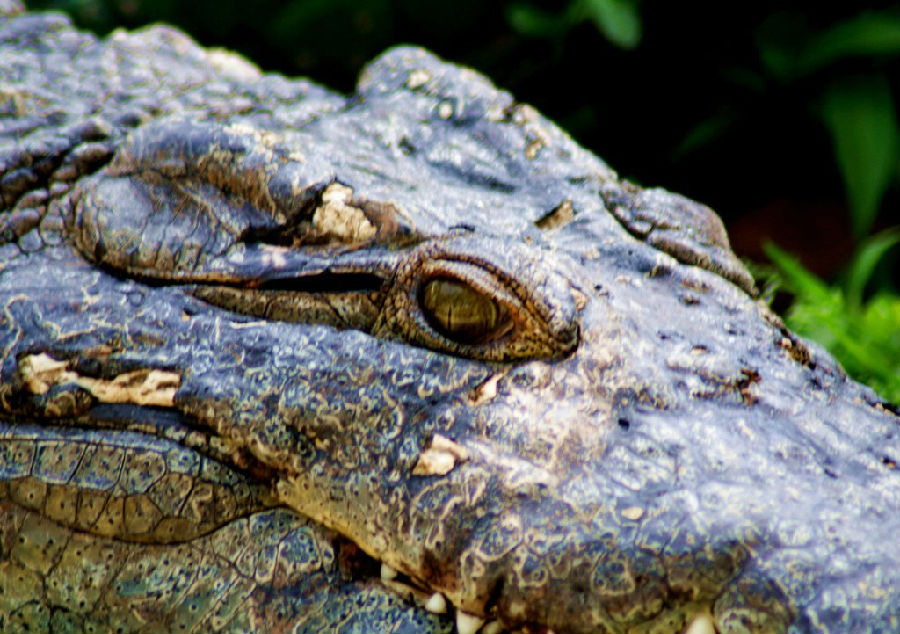
The whole idea of crocodile tears is pretty bizarre. Lore has long held that crocodiles cry when they eat, presumably because they feel bad for killing another animal. It's a phrase that's been used throughout literature to refer to insincere expressions of emotion. The earliest reference to the phenomenon is thought to come from a 1400s text called The Voyage and Travel of Sir John Mandeville, which discusses crocodiles and their tendency to cry as they eat humans.
鳄鱼的眼泪这种说法让人听起来会觉得很怪异。传说中鳄鱼在猎食的时候会流眼泪,可能是因为它们觉得对杀死另一种动物感到愧疚。事实上,这是一个被长期用于文学作品中的谚语,指的是假惺惺的情感。最早的关于此类现象的记载是一篇15世纪的文章,名叫《曼德维尔先生的航海旅游》。文章中讨论了关于鳄鱼这种物种,并且也提到了它们在吃掉其它动物时会流眼泪的倾向。
The idea of crocodile tears as scientific fact has been incredibly hard to prove, as most crocodiles aren't the easiest animals to study up close and also tend to eat in the water. Dismissed as a myth for a long time, the nonexistence of crocodile tears seemed to be confirmed in a questionable study conducted in the last century in which a researcher attempted to see if he could get a crocodile to cry by rubbing onions in its eyes. It didn't cry.It's only been fairly recently that University of Florida zoologists studying crocodile cousins—alligators and caimans—have found that it's not a myth at all, and they really do cry while they're eating. They're just not sure why. It's been generally accepted that it's not an emotional response but rather a physiological phenomenon. The tears might be caused by the sounds that the animals make while they're eating, air passing through the chambers in their skulls, or the pressure that's needed to bite through their prey. It could also be a defensive mechanism, like our own tears, and that their eyes are producing tears as a way of protecting the eye during the fighting that goes on while they're catching and holding their prey. A definitive explanation might be reached with more research, but there's one massive problem in the way. In order to get a good look at what's going on, someone needs to train crocodiles to feed on land. And since they're killing machines with lightning-fast jaws and deadly teeth, no one's volunteered just yet.
要找到关于鳄鱼的眼泪这一说法的科学依据非常非常难,因为作为凶猛异常的动物,鳄鱼不是很容易接近并进行仔细观察研究的动物,它们也习惯于在水中进餐。作为一个很久未解的谜题,上世纪的一个可疑的试验可能证明了鳄鱼并不会流眼泪的说法。试验中,一名研究员将洋葱摩擦在鳄鱼的眼睛里,想以此来看鳄鱼是否会流泪。结果是它并没有流泪。直到最近,弗罗里达大学的动物学家对鳄鱼的近亲——短吻鳄和凯门鳄进行了研究。它们发现这种说法根本不是一个谜题,它们在吃东西的时候确实是会流眼泪,只是不知道流泪的原因而已。大家普遍接受的说法是鳄鱼流眼泪并不是真的愧疚而流泪,而是生理上的现象。它们的眼泪可能是被它们吃掉的动物的叫声而引起的。在它们吃东西时,空气进入它们头骨的脑腔内,或者产生足够的压力来让它们来咬动它们的猎物。这种现象也可能是防御性的原理,就像我们流泪一样,鳄鱼的泪腺分泌出眼泪来保护它们与猎物搏斗中容易受伤的眼睛。要得出一个彻底的结论的话还需要进行更多的研究,但是这中间还有一个大问题。为了更好地观察鳄鱼的状态,必须有人训练它们在陆地上进食。但由于鳄鱼是拥有闪电般咬合速度与致命尖牙的凶残捕食利器,到目前为止,还没有人自愿去完成这一艰巨的任务。
2.Sloths Trek To The Toilet
2.跋涉到厕所的树懒
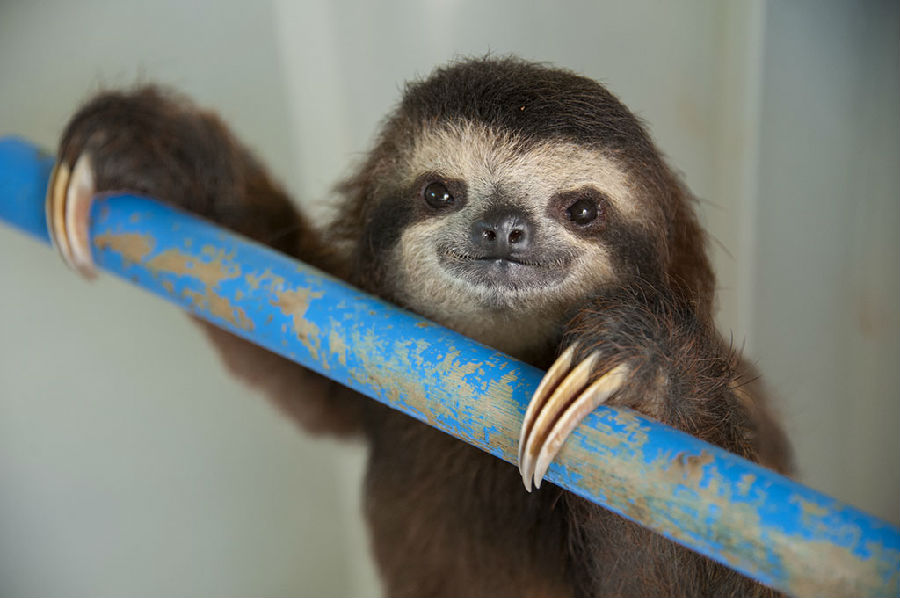
When you think of the sloth, there's pretty much nothing about the animal that suggests it's willing to put any kind of effort into anything. Except, researchers have found, pooping.
一提到树懒,大家想到的可能就是这种动物几乎是懒得做任何事情,除了一件事,那是最近研究员才得出的结果,那就是拉屎。
Most of the sloth's life is spent in the treetops. It's where the food is, it's where they sleep, and it's the safest place for the slow-moving creatures. But once a week, a sloth will make the slow, laborious journey to the ground in order to poop. Once it's finished, it'll head back up into the trees. No one's sure why they go through all the trouble of heading down to the ground; not only does it take a lot of energy, but it's not the safest activity, either. It would be a lot easier just to stay in the trees, out of the reach of predators on the ground, and do what they need to do. There's one main theory about why they do this, and it has to do with the bugs that live in their fur. Sloth fur is pretty disgusting, and it's full of sloth moths. Researchers have suggested that the sloths make the long trip to the ground so that the moths can lay their eggs in the poop, and then, once the bugs hatch, they can head back up to the sloth that most likely hasn't wandered too far away.The problem with that theory comes when you're trying to figure out just what good this is doing the sloth. There hasn't been any proof discovered to indicate that the sloths are getting any benefits out of being home for a lot of bugs. The moths foster a habitat for algae that covers the sloths' fur, but there doesn't seem to be any real benefit in that, either.
树懒生命中大部分时间是在树上度过的,这也是对于像树懒这样行动缓慢的动物来说最安全的方法。但是每星期都有一次,树懒会缓慢而又艰辛地挪动到地面,目的就是为了拉屎。一旦解决了人生大事,它便又会慢慢地爬回树顶去了。没有人知道为什么树懒会如此大费周章地爬到地面,不光是因为这样做要消耗很多体力,还要面临着被捕食者发现的危险。如果就呆在树上远离捕食者的地方完成它们要完成的事儿那该多好。树懒的这种行为目前有一种解释,原因是与在它们皮毛中的虫子有关。树懒的皮毛散发着恶臭并且长满了蛾子。研究人员认为树懒长途跋涉到地面就是为了让身上的蛾子在粪便中产卵,一旦蛾子孵出来,它们便会找到头顶不远处的树懒再寄生到它们的身上。那么这样一来就有了一个问题,树懒这么做到底有什么好处呢?目前为止对于树懒要作为蛾子的宿主会得到什么益处还没有科学的解释。这些蛾子可以为水藻制造一个栖息地,这个栖息地会覆盖整个树懒的皮毛。然而,这并不能为树懒带来什么实质性的好处。
1.Female Elephant Bullies
1.恃强凌弱的母象
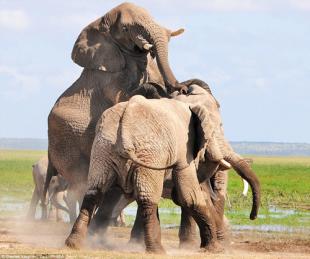
There are few groups thought to be as cooperative as elephants. They help raise each others' young, they protect each other, and they mourn each other when they die. But recently, more observation into the behavior of elephants—particularly female elephants—has suggested that things aren't all rosy-colored at the watering hole, and researchers aren't sure why.
像大象一样互相协作的动物群体不常见。它们互相照顾各自的后代,互相保护对方,并且为同伴的去世而哀悼。但最近的一项关于象群行为的观察研究–特别是母象们——告诉我们事情并不是大家想象的那样美好。研究人员也不清楚为什么结果不是之前人们想象的那样。
In 2013, researchers were staking out a watering hole that was frequented by several family groups of elephants, but behavior at this watering hole was far from what scientists have come to expect from elephant family groups in the wild. While high-ranking females would go out of their way to help other females or help their babies when they got themselves into trouble, they were also going out of their way to block specific females, seemingly chosen at random, from getting to the watering hole. They were going so far as to slap them around and shove their babies out of the way. The behavior was so pronounced that some females were more interested in keeping their companions and babies away from the water than they were in drinking for themselves. It got so bad, continuing day after day, that researchers watched the ostracized females and their young grow steadily weaker and weaker. It was a far cry from the extended family support system that's often observed in elephant groups. Looking out for each other only makes sense. After all, it's how the group survives into the next generation. Why exactly some of the female elephants have chosen very specifically to target other members of their family group is not known. It could be a population density factor or access to food and water, but other studies have indicated that elephants have no problem sharing with other species.
2013年,研究人员秘密监视了好几个象群会经常光顾的水源地,但是象群们在此处的表现与他们之前所设想的相去甚远。当等级高的母象们全心帮助其它同伴或它们的小象时,这些母象同时也排挤其它特定的母象们,看起来这些被排挤对象都是随机选择的,目的就是组织它们到达水源地。它们会拍打这些母象,也会将它们的小象赶出水源地。很明显的是这些母象更专注于将自己的伴侣和小象驱赶出水源地,而不是专注于自己能够饮水。这种现象长此以往,越来越糟,以至于研究者们发现被排挤的母象们和它们的小象逐渐地身体情况变弱。母象们的这种行为和大家所观察到的象群之间互相帮助的情形大为不同。只有互相关照是说得通的。毕竟,这是关系到象群如何能繁衍到下一代的问题。为什么一些母象们选择特定的群体进行排挤是目前我们不得而知的问题。这可能是因为象群密度过多因素或是获得食物和水的因素,但也有其他研究表明象群是可以与其他物种进行食物分享的。
翻译:齐墨; 校对:candy 来源:前十网


